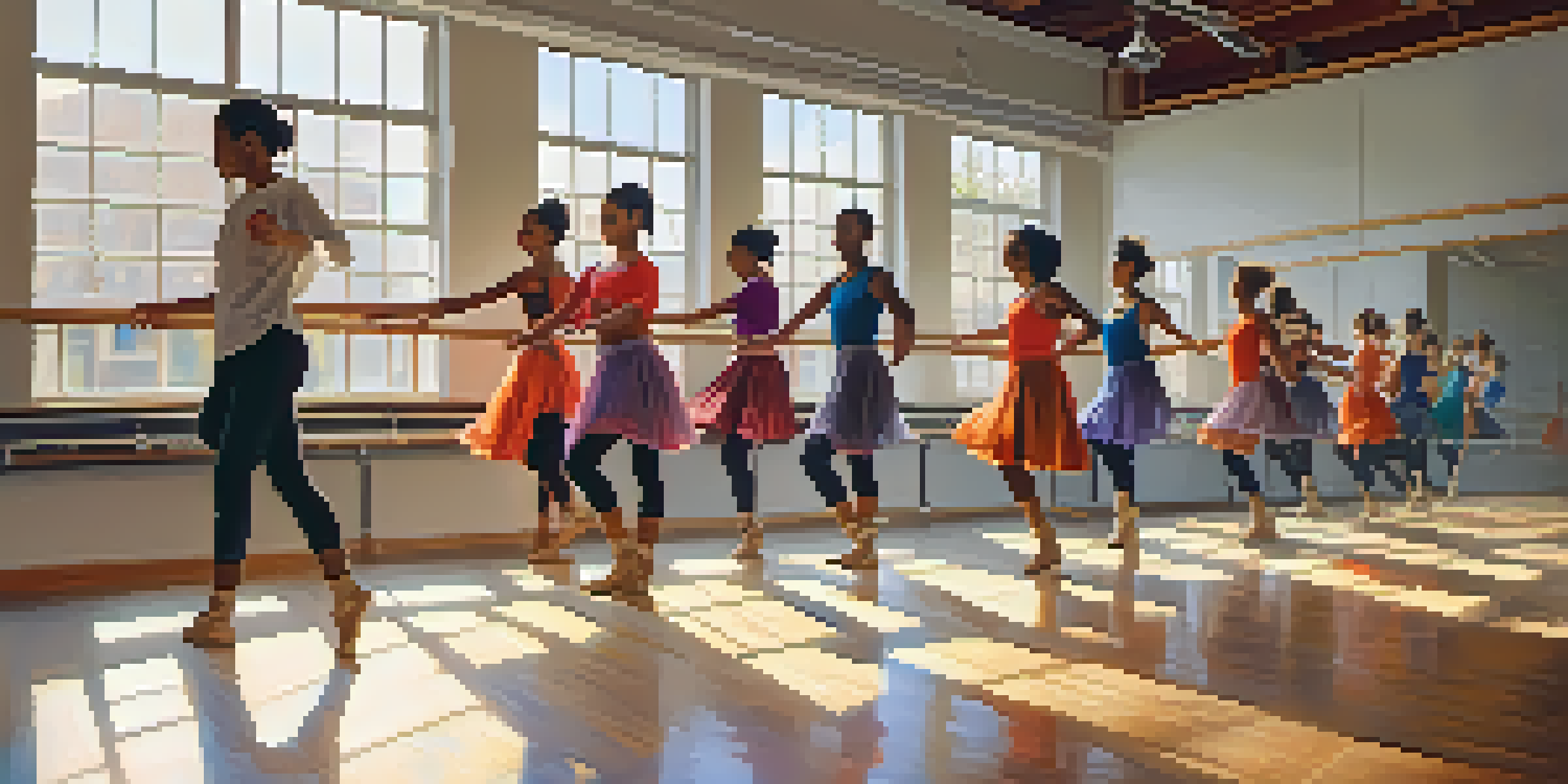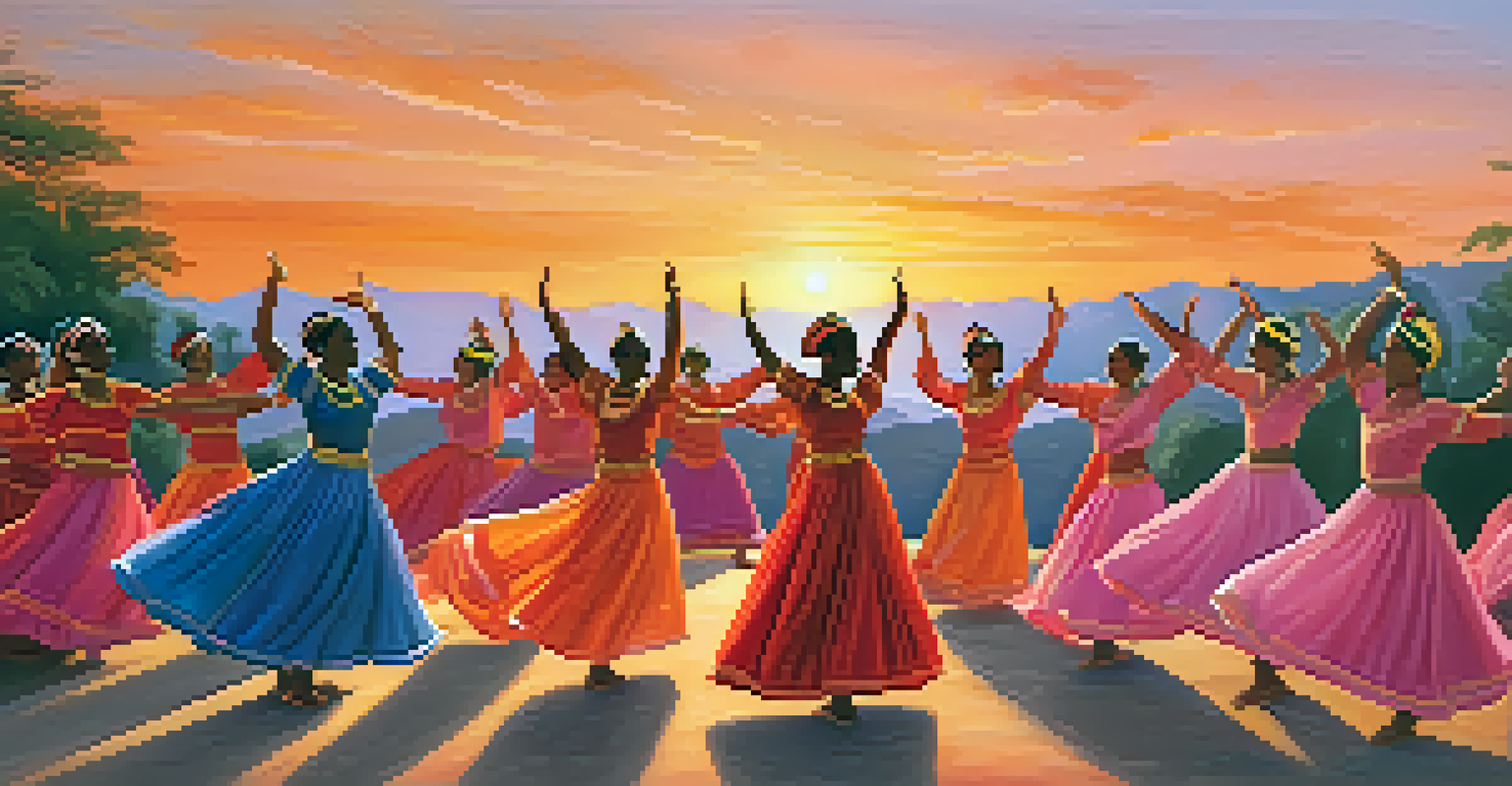Developing Critical Thinking Skills through Dance Education

Understanding Critical Thinking in Dance Education
Critical thinking is the ability to analyze information, evaluate options, and make reasoned decisions. In dance education, this skill becomes essential as students interpret movements and express emotions through their bodies. By engaging in dance, students learn to assess their own performance and that of their peers, leading to deeper self-reflection and awareness.
Dance is the hidden language of the soul.
For example, when learning a new choreography, students must break down complex movements into manageable parts. This process encourages not just physical engagement, but also mental engagement, as they consider how each movement connects to the whole piece. Such analysis fosters a mindset that values inquiry and exploration.
Moreover, dance education often involves improvisation, which requires quick decision-making and adaptability. These experiences empower students to think critically on their feet, honing skills that extend beyond the dance floor into everyday life.
The Role of Collaboration in Dance Learning
Collaboration is a cornerstone of dance education, where students frequently work in groups to create and perform. This teamwork encourages them to listen to different perspectives, negotiate ideas, and reach consensus, all of which are vital components of critical thinking. Through collaborative projects, students learn to articulate their thoughts and critique others' work constructively.

Consider a scenario where a group of dancers must create a piece on a specific theme. Each member contributes unique ideas, and they must discuss and refine these concepts together, weighing the merits of each suggestion. This process not only enhances their creative output but also sharpens their analytical skills as they justify their choices.
Critical Thinking Enhances Dance Skills
Engaging in dance education helps students develop critical thinking by analyzing movements and expressing emotions.
As they navigate disagreements and find common ground, students develop important social skills that complement their critical thinking abilities. These experiences in collaboration empower them to tackle complex problems in various contexts, both in dance and beyond.
Creative Problem-Solving through Dance Challenges
Dance education often presents students with unique challenges that require creative problem-solving. Whether it’s finding a way to express a specific emotion through movement or adapting choreography to fit a new space, students must think critically about how to overcome obstacles. This ability to innovate fosters resilience and adaptability.
The essence of dance is the expression of the human experience.
For instance, when faced with a limitation, such as a small stage, dancers might brainstorm ways to modify their formations to still convey the intended message. This process encourages them to explore multiple solutions and consider the impacts of their choices on the overall performance.
By tackling such challenges, students learn that there are often multiple pathways to achieve a goal. This understanding not only enhances their dance skills but also equips them with a versatile mindset that is invaluable in all areas of life.
Reflective Practices in Dance Education
Reflection is a crucial aspect of developing critical thinking skills in dance education. After classes or performances, students are often encouraged to evaluate their experiences and articulate what they learned. This practice helps them internalize lessons and recognize areas for improvement, fostering a growth mindset.
For example, a student might reflect on their performance and identify specific moments where they felt strong or unsure. By articulating these feelings, they can pinpoint both strengths and weaknesses, leading to targeted practice and development. This self-awareness is fundamental to critical thinking, as it allows them to make informed decisions about their learning paths.
Collaboration Boosts Creative Thinking
Working together on dance projects encourages students to share ideas and refine their creative output while honing analytical skills.
Additionally, sharing reflections with peers can promote discussion and further insights. This collaborative reflection not only deepens their understanding but also cultivates a supportive community that values continuous improvement.
Integrating Technology into Dance Education
In today’s digital age, technology plays a significant role in enhancing dance education. Tools like video analysis, online tutorials, and dance apps allow students to engage with their learning in innovative ways. This integration encourages them to critically evaluate their movements and understand their progression over time.
For instance, using video playback, students can observe their performances from different angles and identify areas that need refinement. This visual feedback is invaluable, as it prompts them to think critically about their technique and execution. By analyzing their work and setting goals for improvement, they cultivate a proactive approach to learning.
Moreover, technology can facilitate collaboration across distances, allowing students to connect and share ideas with peers worldwide. This exposure to diverse styles and perspectives enriches their learning experience and encourages them to think more broadly about dance and its applications.
Cultural Awareness and Critical Thinking in Dance
Dance is a powerful medium for exploring and understanding diverse cultures. Through dance education, students gain exposure to various cultural expressions, which enriches their appreciation for the art form and develops their critical thinking. This exploration fosters empathy and encourages students to think critically about the contexts and meanings behind each dance style.
For example, learning a traditional dance from a different culture requires students to understand its historical and social significance. This deeper understanding prompts them to ask questions and engage in discussions about cultural representation and respect, enhancing their critical thinking skills.
Cultural Awareness Enriches Learning
Exploring diverse dance styles fosters empathy and critical thinking as students understand the cultural contexts behind each form.
By embracing cultural diversity in dance, students learn to approach problems from multiple viewpoints. This cultural awareness not only broadens their horizons but also equips them with the tools to navigate an increasingly interconnected world.
The Long-term Benefits of Critical Thinking in Dance
Developing critical thinking skills through dance education has long-term benefits for students. These skills are transferable and can enhance academic performance, improve decision-making abilities, and foster creativity in various fields. As students become adept at thinking critically, they prepare themselves for success beyond the studio.
For instance, a dancer who learns to analyze movements and create choreography may find these skills invaluable in careers that require strategic thinking and problem-solving. Whether pursuing a career in the arts or another field, the ability to think critically will serve them well.

Ultimately, the critical thinking nurtured through dance education empowers students to approach challenges with confidence and creativity. This mindset not only benefits their personal growth but also contributes positively to their communities.